Lunar New Year recipes from top Los Angeles chefs
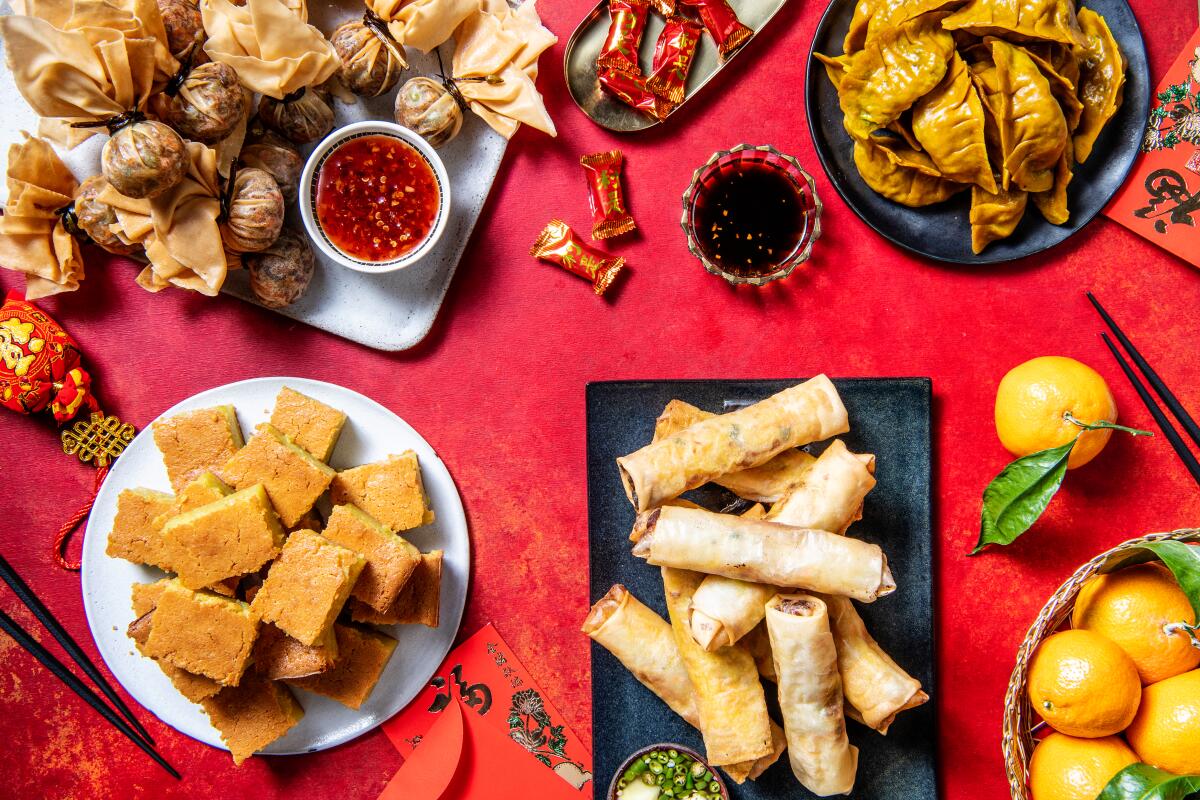
- Share via
It’s the Year of the Rat and horoscope forecasters say that means good fortune. Not as in luck, but as in money: More of it. To speed that promise along, here are a few Lunar New Year dishes traditionally served because they resemble riches: dumplings look like bags of money; bar-shaped foods savory and sweet evoke gold bars.
Shirley Chung of Ms. Chi Cafe in Culver City says she uses turmeric in the wrappers of the vegetable dumplings she makes for New Year so they resemble gold nuggets.
Marie Surakal serves legions of fortune-seekers Lunar New Year meals at Bamboo in the Pechanga Resort Casino in Temecula. This year, she’s preparing thousands of golden bag dumplings. “The dumpling name in Thai means bag of money, so we made them as a family in Thailand to add some lucky charm into our prayers.” Even though the Lunar New Year isn’t a holiday celebrated in Thailand, Surakal says her family is part Chinese so they cooked and feasted together, packaging the money bags in a party assembly line.
“My relatives in the Philippines don’t celebrate Chinese New Year,” said Charles Olalia of the Silver Lake restaurant Ma’am Sir, “But my family here did because my dad’s a doctor and all his Chinese patients gave him food gifts that we’d eat for a week.” At Lunar New Year, Olalia makes Shanghai lumpia with a pork-shrimp filling fried to an auspiciously golden crisp.
When I was growing up, my mom coated slabs of niangao, a dense and sugary glutinous cake, in egg and fried them French-toast style. It was a dessert you had to eat right out of the pan; I’ve found butter mochi, a classic Hawaiian cake, delivers the same tender texture at any temperature and is perfect for toting to parties. Here, I tint the buttery batter gold with turmeric and cut the cake into “gold” bars to portend a year of richness.
Vegan Shiitake Jiaozi With Black Vinegar Dipping Sauce
3 hours. Makes about 50.
Be sure to seal the edges tightly when assembling these dumplings. Because there is no meat binder, a burst dumpling in boiling water will fill it with bits of vegetables and make the water murky. It’s best to make the filling ahead of time and chill it because it’ll hold together more easily when forming the dumplings.
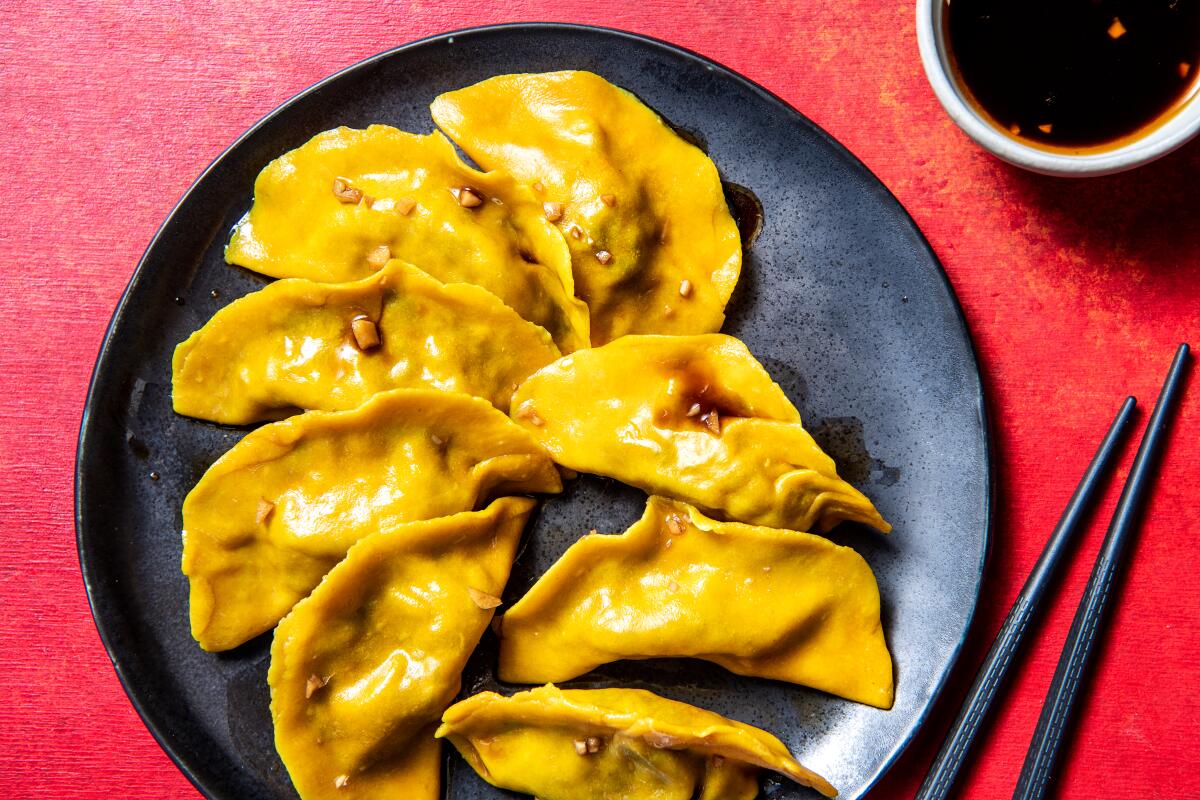
Ingredients
Mushroom Kale Filling
- 8 dried shiitake mushrooms
- 1 ¾ cups shelled edamame, thawed if frozen
- ½ cup canola or vegetable oil
- ½ medium brown onion, finely diced
- 6 garlic cloves, minced
- 1 ¾ pounds kale, stems discarded, leaves shredded
- ½ teaspoon ground white pepper
- Kosher salt
- 1 piece (1 inch) fresh ginger, peeled and minced
- 1 tablespoon plus 1 teaspoon vegan or vegetarian oyster sauce
- 1 tablespoon plus 1 teaspoon soy sauce
- 1 tablespoon toasted sesame oil
Golden Wrappers
- 2 ½ cups all-purpose flour
- 1 tablespoon ground turmeric
- ¼ teaspoon kosher salt
Black Vinegar Dipping Sauce (see recipe below), for serving
Instructions
- To make the filling: Put the mushrooms in a small bowl and add enough boiling water to cover. Put a small saucer over the mushrooms to keep them submerged and soak until tender all the way through, at least 1 hour.
- Meanwhile, pulse the edamame in a food processor, scraping the bowl occasionally, until a smooth paste. Transfer to a large bowl.
- Heat ¼ cup canola oil in a large skillet over medium heat. Add the onion and cook, stirring often, until golden brown, about 5 minutes. Add the garlic and cook, stirring, until fragrant, about 1 minute. Add the kale by handfuls, stirring each addition until wilted before adding the next. Continue cooking, stirring occasionally, until tender but not mushy, about 5 minutes. If the pan starts to scorch, add a splash of water. Remove from the heat, stir in the pepper and season to taste with salt. Transfer to the bowl with the edamame, then rinse out the skillet and wipe dry.
- Drain the shiitakes, then squeeze dry gently on paper towels and finely chop to resemble the texture of ground meat. Heat the remaining ¼ cup canola oil in the same skillet over high heat. When the oil shimmers, add the mushrooms and spread in a single layer. Cook, without stirring, until the bottoms sizzle to a deep golden brown, about 3 minutes. Stir well and continue cooking until evenly browned, about 2 minutes. Season with salt and transfer to the bowl with the kale, along with the ginger, oyster sauce and soy sauce.
- Mix all the filling ingredients together until well-blended. Drizzle with the sesame oil and mix again. Taste and adjust the seasonings as needed. Cover with plastic wrap and refrigerate until ready to use.
- To make the wrappers: Combine the flour, turmeric, salt and ⅔ cup room temperature water in the bowl of an electric mixer fitted with the paddle attachment. Beat on low speed, scraping the bowl and paddle occasionally, until the dough comes together in a smooth clump. Alternatively, stir everything together with your hands or a wooden spoon until it forms a smooth ball. If needed, add more water 1 teaspoon at a time, beating well after each addition. Cover the bowl with plastic wrap and let rest for 30 minutes.
- Take a chunk of dough and roll into a 1-inch-thick rope. Use a sharp knife to cut the rope into ¾-inch pieces, about the size of bottle caps. Using a lightly floured rolling pin, roll a piece on a lightly floured surface into a thin 3- to 4-inch round. Alternatively, flatten the dough into a disk, then use a lightly floured rolling pin to roll the dough into a very thin sheet on a floured surface. Use a 3- or 4-inch round cookie cutter to cut out rounds as close together as possible. Put 1 heaping tablespoon filling in the center of a wrapper. Bring the sides together to form a half-moon shape and pinch the edges tightly to seal. Place on a parchment-paper-lined plate or baking sheet. Repeat with the remaining dough and filling to make more jiaozi.
- Bring a large pot of water to a boil over high heat. Add the jiaozi, in batches if needed to prevent crowding the pot, and boil until they float, 3 to 4 minutes. Adjust the heat during cooking to maintain a steady but not rapid boil. Use a spider or slotted spoon to transfer the dumplings to a serving platter and serve with the dipping sauce.
Black Vinegar Dipping Sauce
5 minutes. Makes about ⅔ cup.
Ingredients
- ½ cup Chinkiang black vinegar
- 1 tablespoon plus 1 teaspoon soy sauce
- 1 tablespoon toasted sesame oil
- 1 tablespoon chile oil
- 4 garlic cloves, minced
Instructions
- Combine the vinegar, soy sauce, sesame oil, chile oil and garlic in a medium bowl. Stir until well mixed.
Make ahead: The filling can be refrigerated in an airtight container for up to 3 days. The assembled uncooked dumplings can be frozen for up to 2 weeks before boiling. The sauce can be refrigerated in an airtight container for up to 3 days.
Adapted from Shirley Chung.
Golden Bag Chicken Dumplings With Thai Sweet Chili Sauce
2 hours. Makes 20.
Surakal has adapted her family’s traditional Thai filling by adding vegetables she’s come to love since cooking and living in America. The sweet potato, carrots and peas lend a natural sweetness to the savory chicken base.
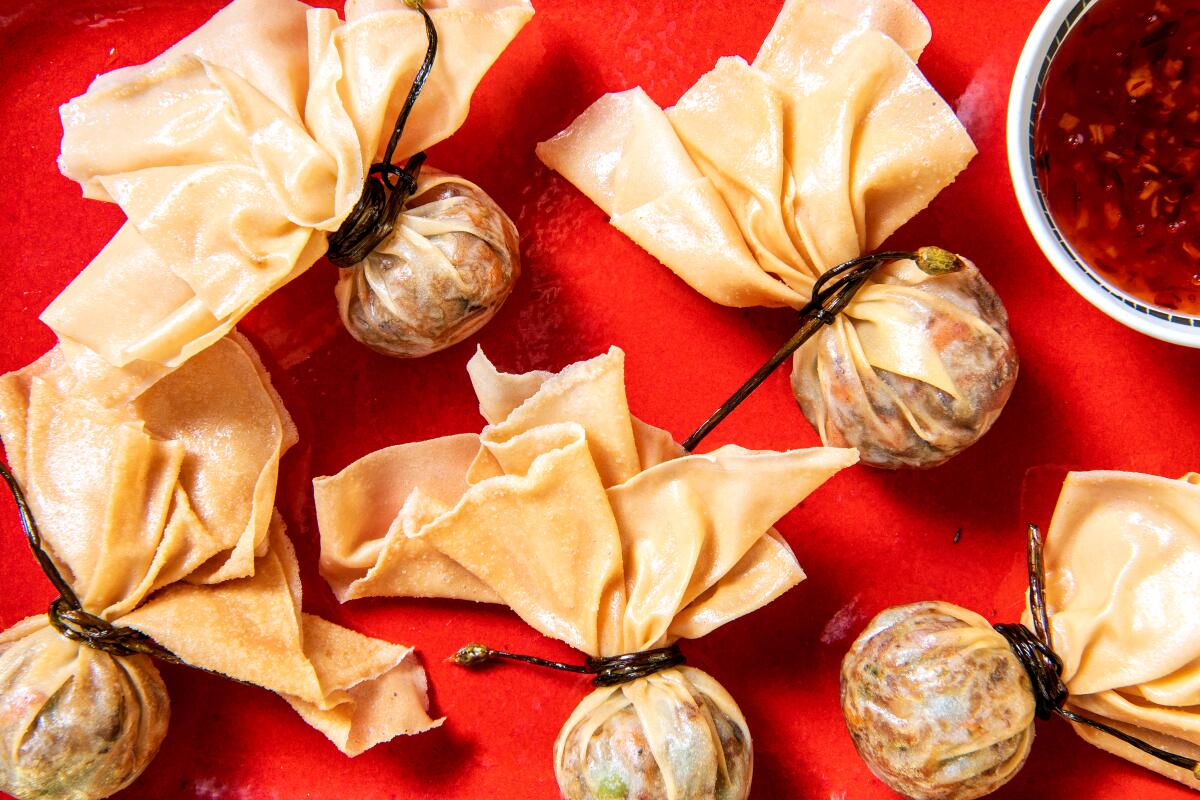
Ingredients
- 20 Chinese chives
- Kosher salt
- ¼ cup finely diced peeled sweet potato
- 1 tablespoon oyster sauce
- 1 tablespoon granulated sugar
- 1 tablespoon cornstarch
- 1 teaspoon freshly ground black pepper
- 6 ounces packed ground dark meat chicken (½ cup)
- 3 garlic cloves, minced
- 2 tablespoons finely chopped cilantro stems
- 3 tablespoons canola or vegetable oil, plus more for frying
- 3 fresh shiitake mushrooms, trimmed and finely chopped
- ¼ cup coarsely grated carrot
- ¼ cup frozen green peas, thawed
- 20 sheets (8-inch-square) spring roll wrappers, preferably TYJ brand
- Thai Sweet Chili Sauce (see recipe below), for serving
Instructions
- Bring a medium saucepan of water to a boil. Fill a large bowl with ice and water. Add the chives to the boiling water and boil for 5 seconds. Use tongs to immediately transfer to the ice water. When cool, drain the chives on paper towels, patting very dry.
- Bring the water in the saucepan back to a boil. Add the sweet potato and cook until almost tender, about 3 minutes. Drain well and reserve.
- Mix the oyster sauce, sugar, cornstarch and pepper in a small bowl to make a sauce. Combine the chicken, garlic, cilantro and 2 tablespoons of the sauce mixture in a large bowl. Mix until well blended; reserve the remaining sauce.
- Heat the oil in a wok or large skillet over high heat. When the oil shimmers, add the chicken mixture and cook, stirring and breaking the meat into small bits, until lightly browned, about 2 minutes. Add the mushrooms, carrot, peas and reserved sweet potato and cook, stirring, for 2 minutes. Add the remaining sauce and cook, stirring until the sauce thickens and evenly coats everything, about 1 minute. Season to taste with salt. Transfer to a bowl, then refrigerate to chill, about 1 hour.
- Put a spring roll wrapper on a work surface and put 1 heaping tablespoon filling in the center. Draw up all the sides of the wrapper and gather around the filling to form a pouch. Wrap one chive around the cinched part at least two times, then tie to secure. Repeat with the remaining wrappers, filling and chives to make more dumplings.
- Fill a saucepan with oil to a depth of 3 inches. Heat over medium-high heat until a deep-fry thermometer registers 350 degrees. Working in batches, add the dumplings to the hot oil (avoid overcrowding) and fry, turning to evenly cook, just until golden brown and crisp, 2 to 3 minutes. Transfer to paper towels to drain. Serve hot with the sweet chili sauce.
Thai Sweet Chili Sauce
20 minutes. Makes about 1 ½ cups.
Ingredients
- 1 cup granulated sugar
- ⅓ cup distilled white vinegar
- 3 tablespoons sambal oelek (ground fresh chili paste)
- 2 large garlic cloves, finely chopped
- ½ teaspoon kosher salt
Instructions
- Combine the sugar, vinegar, sambal, garlic and salt in a small saucepan. Bring to a boil over medium-high heat, stirring to dissolve the sugar. Reduce the heat to medium and simmer rapidly, stirring occasionally, until syrupy in consistency, about 10 minutes. Cool to room temperature and serve.
Make ahead: The filling can be refrigerated in an airtight container for up to 3 days. The sauce can be refrigerated in an airtight container for up to 1 week.
Adapted from Marie Surakul.
Pork and Shrimp Lumpia Shanghai With Cracked Pepper Coconut Vinegar Sauce
3 hours. Makes 30.
For a milder dipping sauce, you can substitute serranos for the Thai chiles and seed them.
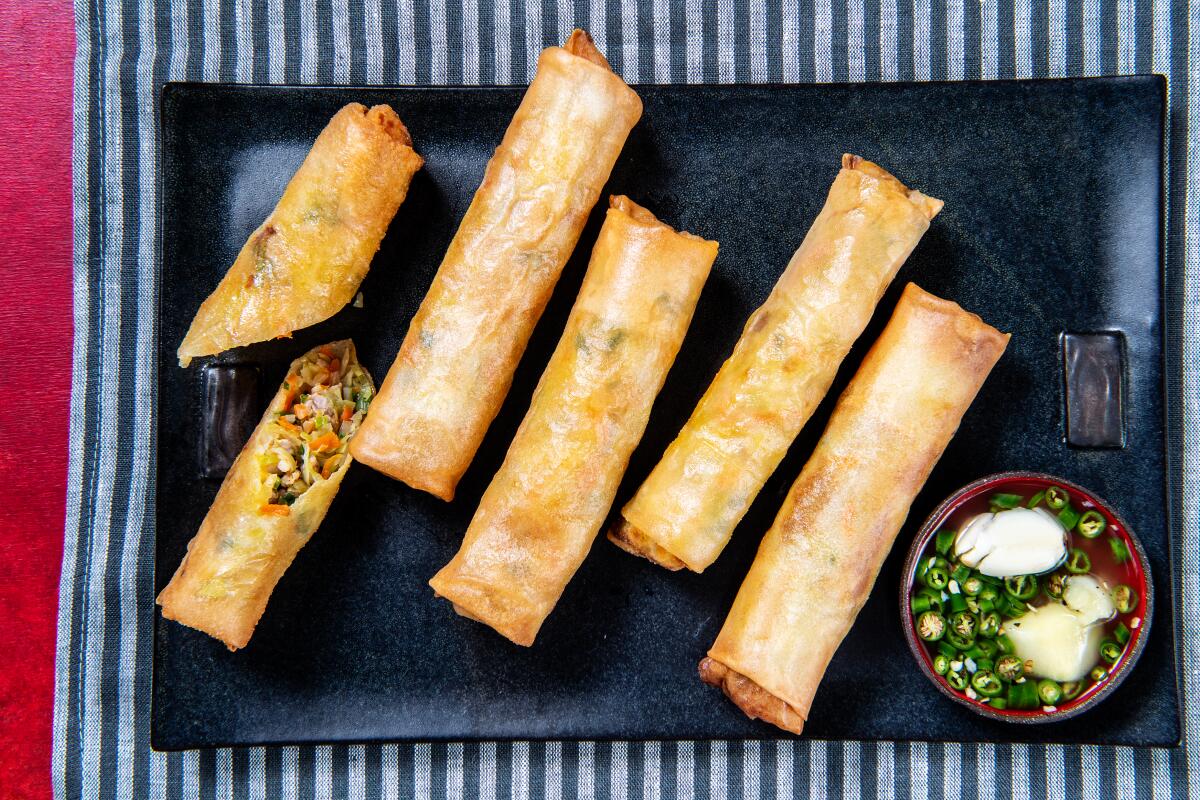
Ingredients
- ½ teaspoon light soy sauce
- ½ teaspoon cornstarch
- 1 ½ teaspoons granulated sugar
- ½ teaspoon kosher salt
- Pinch of ground white pepper
- ½ teaspoon Maggi seasoning (optional)
- 6 ounces ground pork, preferably fatty
- 6 ounces peeled and deveined shrimp, coarsely chopped
- ¼ cup plus 1 tablespoon vegetable oil, plus more for frying
- 8 cups shredded cabbage
- 1 cup coarsely grated carrots
- 1 cup thinly sliced scallions
- 1 teaspoon toasted sesame oil
- 30 sheets (8-inch-square) spring roll wrappers, preferably TYJ brand
- 1 large egg white
- Cracked Pepper Coconut Vinegar Sauce (see recipe below), for serving
Instructions
- Mix the soy sauce, cornstarch, sugar, salt, white pepper and Maggi, if using, in a medium bowl. Pour half the marinade into another medium bowl. Put the pork in one and the shrimp in the other. Mix each well, then cover with plastic wrap and marinate in the refrigerator for 1 hour.
- Meanwhile, heat ¼ cup oil in a wok or large skillet over high heat. When the oil starts to smoke, add the cabbage, carrots, scallions and a pinch of salt. Cook, stirring, until the vegetables wilt, 3 to 4 minutes. Transfer to a large bowl and refrigerate to chill. Rinse out and dry the wok.
- After the pork and shrimp have marinated, heat 1 tablespoon vegetable oil in the wok over high heat until shimmering. Add the pork and cook, stirring to break into small bits, for 1 minute. Add the shrimp and cook, stirring, until opaque, about 10 seconds. Remove from the heat and stir in the sesame oil. Transfer to the bowl with the vegetables and stir until well mixed. The filling should be cool or room temperature. If it’s hot, refrigerate to cool.
- Whisk the egg white with 2 tablespoons water until well-blended. Put a spring roll wrapper on a work surface and spoon a line of filling (2 to 3 tablespoons) parallel to and 2 inches away from the side closest to you, leaving a 1 to 2 inch rim on the sides perpendicular to the line of filling. Fold the side closest to you over the filling, then fold in the ends and continue rolling until you have 1 1/2 inches remaining. Brush egg white on that edge to seal and finish rolling. Repeat with the remaining wrappers, filling and egg white wash to make more lumpia.
- Fill a saucepan with oil to a depth of 2 inches. Heat over medium-high heat until a deep-fry thermometer registers 325 degrees. Working in batches, add the lumpia to the hot oil (avoid overcrowding) and fry, turning to evenly cook, just until golden brown and crisp, 4 to 5 minutes. Transfer to paper towels to drain. Serve hot with the vinegar sauce.
Cracked Pepper Coconut Vinegar Sauce
5 minutes. Makes about 1 cup.
Ingredients
- 1 cup coconut vinegar
- 6 garlic cloves, crushed and peeled
- 1 piece (½ inch) fresh ginger, smashed
- ¼ cup sliced Thai chiles
- 1 ½ teaspoons cracked black pepper
Instructions
- Combine the vinegar, garlic, ginger, chiles and pepper in a small bowl. Stir well.
Make ahead: The filling can be refrigerated in an airtight container for up to 3 days. The sauce can be refrigerated in an airtight container for up to 1 week.
Adapted from Charles Olalia.
Golden Butter Mochi
1 ½ hours, largely unattended. Makes about 4 dozen.
Right after the mochi cool, they’re still quite sticky when you cut them. If you prefer more cakey mochi and clean edges on your cuts, let them cool overnight before slicing.
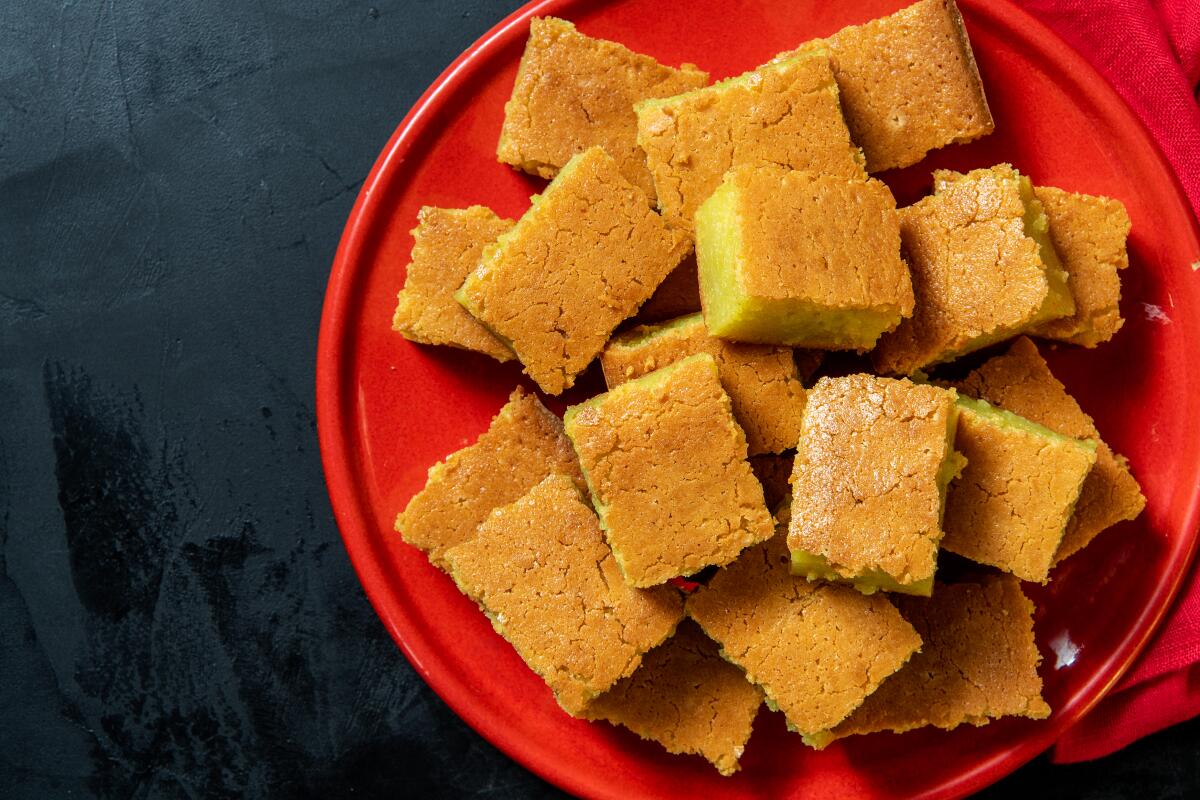
Ingredients
- 1 box (1 pound) sweet rice flour, such as Mochiko brand
- 1 tablespoon baking powder
- ½ teaspoon ground turmeric
- 4 large eggs
- 2 cups granulated sugar
- 2 cans (13.5 ounces each) unsweetened full-fat coconut milk, well-shaken
- 1/2 cup salted butter, melted and cooled
- 1 tablespoon pure vanilla extract
Instructions
- Heat the oven to 350 degrees. Lightly coat a 9-by-13-inch metal baking pan with nonstick cooking spray, line the bottom and sides with parchment paper and spray the parchment.
- Whisk the rice flour, baking powder and turmeric in a large bowl. Beat the eggs and sugar in another large bowl with an electric mixer on medium-high speed until pale yellow. Reduce the speed to medium and pour in the coconut milk in a steady stream, then the butter and vanilla. Scrape down the bowl. Reduce the speed to low and gradually add the dry ingredients, beating until smooth. Alternatively, whisk the ingredients by hand, adding them in the order above. Pour the batter into the prepared pan.
- Bake until golden brown and the edges are just starting to pull away from the sides of the pan, about 1 ½ hours.
- Cool completely in the pan on a wire rack. Cut into quarters lengthwise, then cut each quarter into 1-inch-wide bars to form 48 rectangles.
Make ahead: The bars will keep in an airtight container at room temperature for up to 3 days.
More to Read
Eat your way across L.A.
Get our weekly Tasting Notes newsletter for reviews, news and more.
You may occasionally receive promotional content from the Los Angeles Times.











